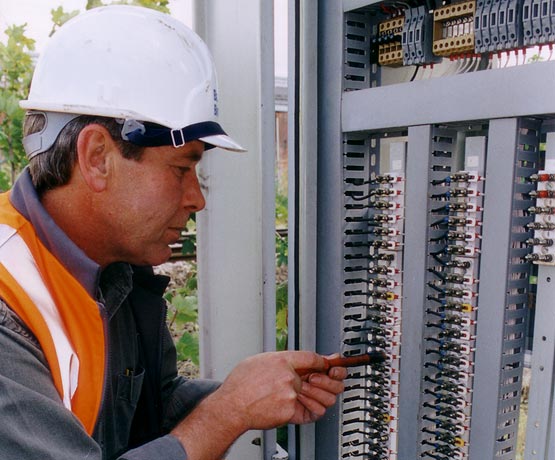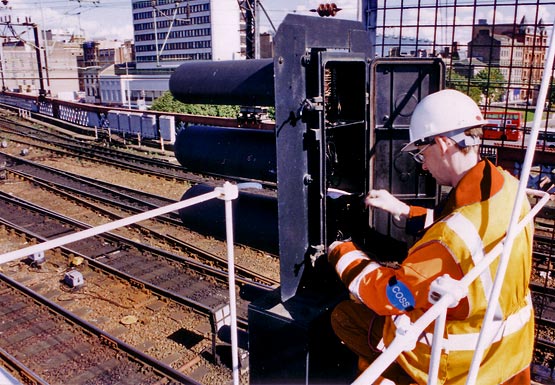Coming up roses
by Stuart Marsh
Ask any organisation about maintenance costs and you’d be hard pushed to find one that thinks theirs are too low. Maintenance could be said to represent an overhead, a burden even, that begs to be reduced, but we all know it’s not that simple.
Maintenance comes in two flavours - proactive and reactive. Proactive, scheduled, planned or whatever you like to call it is intended to reduce the unplanned, show-stopping failures that themselves carry an even greater cost. Simple isn’t it? Well, no, not really. There’s a balance to be reached between the cost of failures and the cost of preventing them. How does an organisation know where to strike that balance and how can it be achieved?
 |
| Work in a location cabinet near York Station. |
The preventative alternative
Like any railway operator or company in industry, Network Rail is faced with just this dilemma. On something as vastly complex as our national rail network, it’s a tricky subject and one that has not been without controversy in recent months. Compensation payments to train operators caused by infrastructure failures can be massive and what about the poor suffering passengers?
The incidence of failures can be reduced by undertaking preventative maintenance on the systems that can fail and keeping tabs on their condition. This can be accomplished by sending people out to work on the kit yet this itself can lead to denial of services and expose those involved to hazards. Alternatively, it might be possible to install equipment that doesn’t fail and needs less maintenance, then remotely monitor it in service, looking for the early signs of problems. Such an approach opens up opportunities to react to that information at a time that’s convenient and to look after the equipment cleverly by making efficient use of a skilled workforce. It’s something that’s been happening in industry for years.
|
| ...it might be possible to install equipment that doesn’t fail and needs less maintenance... |
|
Network Rail is looking particularly at its maintenance regime for signalling equipment. It owns roughly 250,000 signalling assets, all of which need to be looked after. A scheme that takes a more tailored approach to the way these are maintained is helping to improve reliability levels.
The company’s ROSE programme - reliability-centred maintenance of signalling equipment - focuses on developing a bespoke maintenance regime for each signalling asset, determined by its usage, environment and condition. It complements condition monitoring (CM) and remote condition monitoring (RCM), enabling teams to extract the greatest value from their resources by working more effectively when they have access to the track, thereby keeping line blockages to a minimum. In turn, this reduces disruption and its associated costs. The programme has now passed a major milestone having being rolled out to more than 100,000 assets.
Traditionally, signalling maintenance has taken a ‘one size fits all approach’ with assets being maintained on the same cycle regardless of factors such as location and age. ROSE uses the concept of reliability-centred maintenance developed in the aviation industry and now accepted as best practice in other industries including nuclear and petrochemical.
“Big gains are being made by working smarter in the way we do maintenance” says Steve Featherstone, Network Rail’s maintenance director. “Using the experience and knowledge of our engineers to develop maintenance regimes which focus on reducing and removing the causes of failures saves time and frees up resources that can be put to more effective use.”
In practice, this could be something ludicrously simple or it could be more technologically based. Take for example the humble colour light signal. The traditional version with filament lamps needs to be visited every three months. And how many S&T technicians does it take to change a light bulb? Someone once worked out that it was nine, but let’s not go there! So, the signal head can be changed out for a new LED version which only needs to be visited once a year, and even that’s really only to clean the lenses. But if the book still says that the signal has to be checked every three months, isn’t it time to update the book?
 |
| Signal maintenance work at Glasgow Central. |
At the other end of the scale, let’s consider a complex point actuation system such as the IAD Rail Systems HPSS. This lends itself very well to CM which is probably because its internal electronic systems were designed that way! Operational details based on motor current, actuation times, switch rail positioning etc are stored and can be accessed using a handset, with future provision for remote access (RCM). Any departure from the recorded datum can be used to flag up an alert before a failure has occurred.
Even in older systems, RCM can facilitate trend-based fault prediction. Measurement of the hydraulic pressure in Clamp Lock point systems can be used to produce a similar fingerprint of the point operating cycle (trialled at Wallneuk Junction, Paisley). Load cells and other sensors have been applied to conventional point machines with a similar objective (trialled at Norton Bridge Junction). The performance of other signalling assets too, such as level crossing systems, can be monitored.
Together with RCM - albeit currently in planning - Network Rail’s ROSE initiative should provide a significant step forward in the efficiency and effectiveness with which it maintains its signalling infrastructure. It was Shakespeare’s Juliet who voiced that a rose by any other name would smell as sweet. Some might retort that ROSE carries a whiff of redundancies and further suggest that such a move could compromise safety. Yet ROSE does not signify a reduction in maintenance; in some cases it could mean more, or perhaps just a different way of delivering it to a particular asset.
The equivalent of ROSE and condition monitoring has been the norm elsewhere for many years - industries in which the access of staff to hazardous areas would not be tolerated for an instant. By any standards, an active railway is a hazardous environment for those working on it. Network Rail seeks to minimise the risks faced by its staff and, at the same time, has no choice but to cut its costs. Just as there has to be a balance between the costs of proactive and reactive maintenance, there surely needs to be a balance between the efficient use of a skilled maintenance workforce and the use of technology. There will no doubt be more arguments to come on this subject. As someone with more wit than me once said, life is a rose but beware of the thorns!
Story added 1st July 2010
|